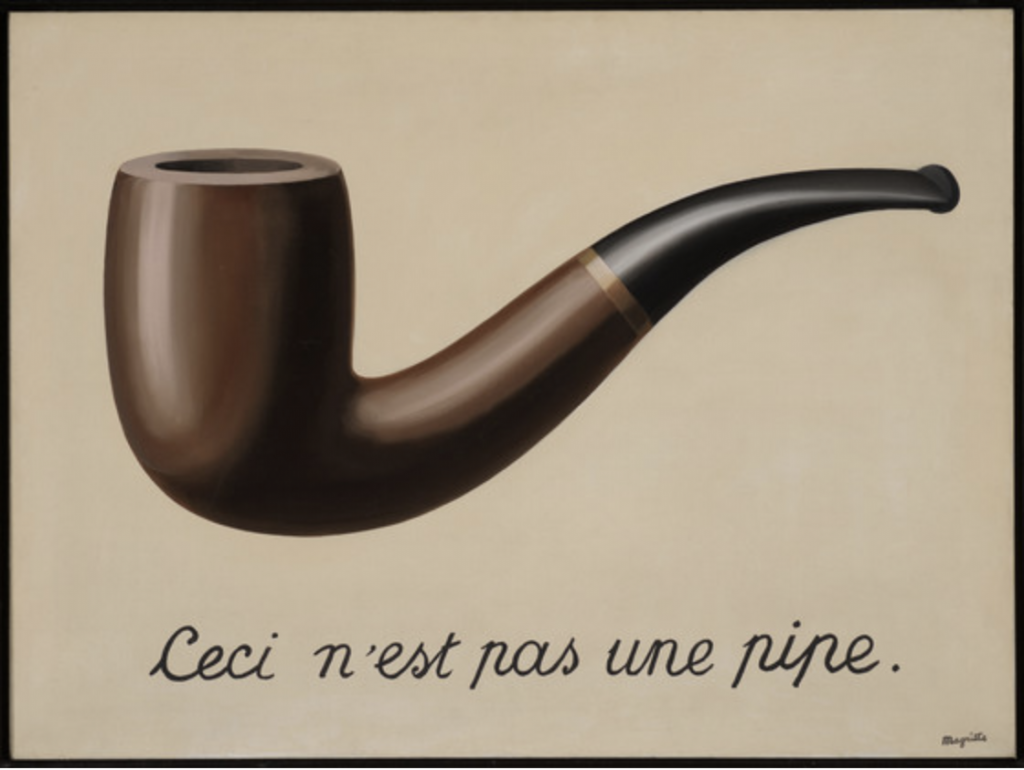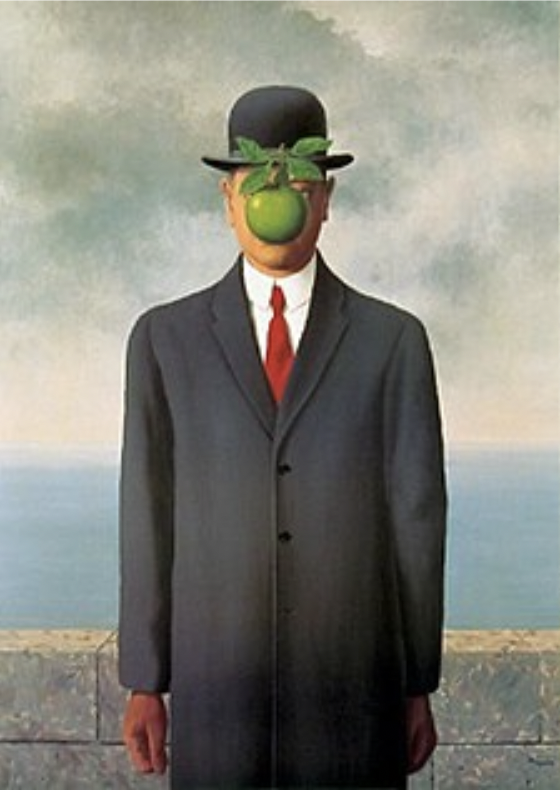Magritte, René. “The Son of Man.” 1964.
A few days ago, as I was walking down the street, I was taken aback by a poster advertising the Caixa Bank’s current art exhibition: the works of surrealist René Magritte. Most people will claim they have no idea who he is, but will instantly recognize his style once they are shown one of his most notable works- The Son of Man, his self portrait.
Look closely and you will notice his eyes peeking through the apple (the fruit is a recurring symbol found in his artworks). The apple in this painting has inspired, among others, the Apple logo, the name of the computer, and the logo of Apple Records, a multimedia company founded by the Beatles. Despite The Son of Man’s popularity, the work is owned by a private collector, so it barely goes on display. Fortunately, Magritte created a variety of works during his lifetime that can hopefully compensate for the viewers eager to see his most famous work.
The meaning behind this piece has been debated by critics time and time again; some theorize that it is a religious painting since the phrase “Son of Man” refers to Jesus in the Christian faith.
Magritte, however, claims the work is an exploration of the inexplicit:
“At least it hides the face partly. Well, so you have the apparent face, the apple, hiding the visible but hidden, the face of the person. It’s something that happens constantly. Everything we see hides another thing, we always want to see what is hidden by what we see. There is an interest in [what] is hidden and which the visible does not show us. This interest can take the form of a quite intense feeling, a sort of conflict, one might say, between the visible that is hidden and the visible that is present.”
From this, those unfamiliar with his works will note that a key aspect of this witty artist is the distinct line he created between the ordinary objects and their intended purpose, provoking the observers to view them through a different lens; more specifically, interpreting mundane objects as mysterious and unknowable.
In an interview, Magritte voiced his thought process behind his creations: “I’ve got nothing to express. I simply search for images and I invent…only the image counts, the inexplicable and mysterious image, because all is mystery in our life.”

Caption: “This is not a pipe”
Magritte was known as one of the leading figures of the surrealist movement. What distinguishes him from his contemporaries is that his surrealist perspective was incorporated into objects that represented contemporary life.
As an avid fan of surrealism, I was enthralled by his works when I first saw them at the Thyssen-Bornemisza Museum in Madrid during an art trip. My attention was piqued by his whimsical, logic-defying depiction of daily objects when viewing “The Treachery of Images”. As a matter of a fact, I was nearly abandoned in the exhibition by my peers because I spent so much time observing each painting of his, detail after detail.
Those who look closely at his works will notice thick and crusty layers of paint. This technique makes the daily objects he portrays look tangible and it was seldom used at the time. On top of that, he mainly used traditional drawing techniques, such as chiaroscuro (which consists of a strong contrast between two subjects through the use of their colors) to make the subject(s) of the painting stand out.
Magritte has impacted the art scene with his timeless body of work that captures the spirit of the 20th century. Nearly six decades after his death, he is still widely recognized for his surrealist depiction of mundane imagery, which makes him one of my favorite artists to date. Sometimes it can feel refreshing to enjoy inanimate objects for what they are, rather than trying to find a deeper meaning, which is why I encourage my readers to check out his works.
Bibliography:
Abrams, Amah-Rose. “The Surreal Legacy of Adman-Turned-Fine-Artist René Magritte.” Artnet
News. 30 Nov 2015.
Arn, Jackson. “Magritte’s Prophetic Surrealism.” Boston Review. 8 Mar 2022.
https://bostonreview.net/articles/magrittes-prophetic-surrealism/.
Kurchanova, Natasha. “Magritte’s Lonely Art.” Studio International. 25 Nov 2013.
https://www.studiointernational.com/index.php/magrittes-lonely-art.
Puchko, Kristy. “10 Things You Might Not Know About The Son of Man Kristy Puchko.”
Mental Floss. 27 Apr 2015.
https://www.mentalfloss.com/article/63241/10-things-you-might-not-know-about-son-man.
Silver, Craig. “How A Magritte Painting Led to Apple Computer.” Forbes. 5 Dec 2013.
https://www.forbes.com/sites/craigsilver/2013/12/05/how-a-magritte-painting-lead-to-apple-computer/.
“The Son of Man.” Wikipedia. 19 Feb 2022. https://en.wikipedia.org/wiki/The_Son_of_Man.
“THE SURREALIST WORK OF MAGRITTE THE SON OF MAN.” Art Pieces.
http://www.artpieces.net/son-of-man.html.
Turner, Christopher. “Meet Magritte – the man behind the apple.” Apollo Magazine. 18 Mar
2022. https://www.apollo-magazine.com/magritte-life-alex-danchev-review/.
“René Magritte – Biography and Legacy.” The Artstory.
https://www.theartstory.org/artist/magritte-rene/life-and-legacy/#:~:text=By%20the%20late%
201930s%20however,up%20commercial%20work%20almost%20completely.
“Rene Magritte Quotes.” René Magritte.
https://www.renemagritte.org/rene-magritte-quotes.jsp#:~:text=Rene%20Magritte%20Quotes,a%20translation%20of%20the%20dream.%20%E2%80%9D&text=Art%20evokes%20the%20mystery%20without%20which%20the%20world%20would%20not%20exist.%20%E2%80%9D&text=Everything%20we%20see%20 hides%20another,hidden%20by%20what%20we%20see.%E2%80%9D.
“René Magritte and The Birth of Surrealism.” Artsper Magazine. 15 Sep 2014
https://blog.artsper.com/en/a-closer-look/magritte-and-the-birth-of-surrealism/.

